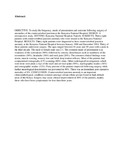Abstract
OBJECTIVE:
To study the frequency, mode of presentation and outcome following surgery of anomalies of the craniovertebral junction at the Kenyatta National Hospital.
DESIGN:
A retrospective study.
SETTING:
Kenyatta National Hospital, Nairobi.
SUBJECTS:
Thirty eight patients with craniovertebral junction anomaly who were treated at the Kenyatta National Hospital.
RESULTS:
Thirty eight patients were diagnosed to have craniovertebral junction anomaly at the Kenyatta National Hospital between January 1988 and December 1994. Thirty of those patients underwent surgery. The ages ranged between 10 years and 49 years with a peak in the third decade. The male to female ratio was 2:1. The common mode of presentation was weakness of the extremities (90%) followed by sensory disturbances such as numbness of the extremities (30%), headache (30%) and neck pain (20%). The common clinical findings were ataxia, muscle wasting, sensory loss and brisk deep tendon reflexes. Most of the patients had computerised tomography (CT) scanning (80%) done. Other radiological investigations which were done were plain x-rays of the skull and cervical spine (50%), myelographic studies (36%) and tomographic studies (12%). Forty percent of the patients improved following surgery while further neurological deterioration was prevented in 48%. There was an immediate post-operative mortality of 8%.
CONCLUSION:
Craniovertebral junction anomaly is an important clinicopathological, condition common amongst certain ethnic groups found in high altitude areas of the Kenya. Surgery may cause clinical improvement in 40% of the patients, mainly those who have been symptomatic for less than three years.

